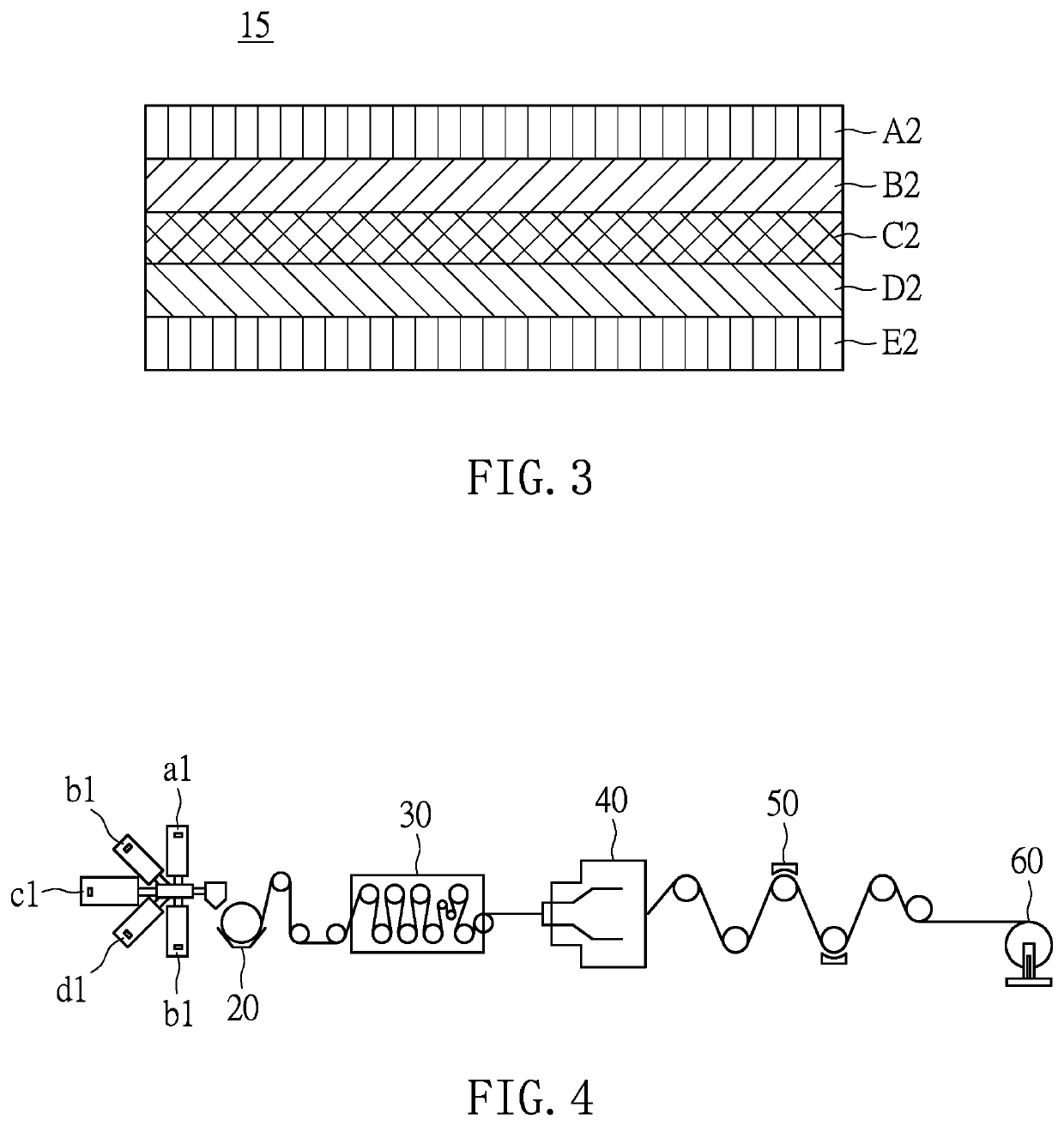Matte synthetic paper
a synthetic paper and matt technology, applied in the field of matt synthetic paper, can solve the problems of achieving the goal of replacing natural paper products, the quality of biaxially oriented polypropylene synthetic paper, etc., and achieve the effect of no pit defects, high gloss, and no haz
- Summary
- Abstract
- Description
- Claims
- Application Information
AI Technical Summary
Benefits of technology
Problems solved by technology
Method used
Image
Examples
first embodiment
[0064]Referring to the raw material formulation of Table 1, the raw materials of the printing surface layer of the synthetic paper are formulated, including mist flour M.B 8 wt %, polypropylene 57 wt %, titanium dioxide M.B 15 wt %, calcium carbonate M.B 15 wt %, and antioxidant M.B 5 wt %.
[0065]Referring to a manufacturing process shown in FIG. 2, after three extruder fusion co-press processes, through a rapid cooling of a cooling molding device, a three-layer laminate is formed at a temperature of 15 to 70° C. The three-layer laminate is longitudinally extended 4 times by a longitudinal extension device at a temperature of 155-150° C., and then transversely extended 8 times by a transverse extension device at a temperature of 140-200° C. After that, a surface tension is increased by a corona treatment of 60 kw power high-frequency, that is, an 80 μm three-layer co-extruded biaxially stretched synthetic paper product is obtained.
[0066]The physical properties of the printing surface...
second embodiment
[0067]Referring to the raw material formulation of Table 1, the raw materials of the printing surface layer of the synthetic paper are formulated, including mist flour M.B 16 wt %, polypropylene 40 wt %, titanium dioxide M.B 15 wt %, calcium carbonate M.B 15 wt %, and antioxidant M.B 5 wt %.
[0068]An 80 μm three-layer co-extruded biaxially stretched synthetic paper product is obtained by the same processing method of the first embodiment.
[0069]The physical properties of the printing surface layer of the obtained synthetic paper are shown in Table 1.
third embodiment
[0070]Referring to the raw material formulation of Table 1, the raw materials of the printing surface layer of the synthetic paper are formulated, including mist flour M.B 4 wt %, polypropylene 61 wt %, titanium dioxide M.B 15 wt %, calcium carbonate M.B 15 wt %, and antioxidant M.B 5 wt %.
[0071]An 80 μm three-layer co-extruded biaxially stretched synthetic paper product is obtained by the same processing method of the first embodiment.
[0072]The physical properties of the printing surface layer of the obtained synthetic paper are shown in Table 1.
PUM
| Property | Measurement | Unit |
|---|---|---|
| thickness | aaaaa | aaaaa |
| melting point | aaaaa | aaaaa |
| wt % | aaaaa | aaaaa |
Abstract
Description
Claims
Application Information
 Login to view more
Login to view more - R&D Engineer
- R&D Manager
- IP Professional
- Industry Leading Data Capabilities
- Powerful AI technology
- Patent DNA Extraction
Browse by: Latest US Patents, China's latest patents, Technical Efficacy Thesaurus, Application Domain, Technology Topic.
© 2024 PatSnap. All rights reserved.Legal|Privacy policy|Modern Slavery Act Transparency Statement|Sitemap


